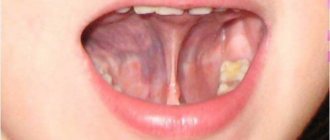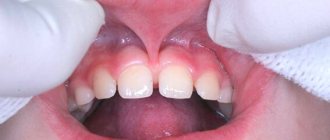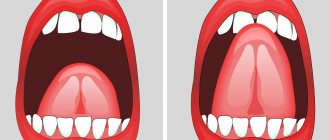Unfortunately, even parents who are not privy to medical subtleties are familiar with the opinion that a short frenulum of the tongue in a child is the cause of speech therapy problems.
Why "Unfortunately"? Because it is ignorance of the material that leads to a clear decision - the bridle needs to be trimmed! Do you remember in the film “Pokrovsky Gate” the characteristic female surgeon with her famous phrase “Cut!.. without waiting for peritonitis”? So the same thing often happens to the poor bridle. However, as experience shows, there is not always only one way out. Not every case of the so-called “short frenulum” requires radical measures.
What is a short frenulum of the tongue?
The frenulum is a thin partition that connects the tongue and the lower oral cavity. Normally, the frenulum is quite elastic, stretches well and is attached to the tongue in its middle part.
An abnormal structure may be the location of the frenulum closer to the edge of the tongue or even at its tip. In addition, a significant decrease in its elasticity, that is, its ability to stretch, is possible.
So in fact, the concept of “short bridle” is not entirely correct. Therefore, there is no clear solution to this issue.
Additional special exercises
Exercise No. 1. Slowly push the lower jaw forward until the cutting edges of the lower incisors are positioned in front of the upper ones. Hold the lower jaw in this position for 10 seconds, then slowly return to its original position.
Exercise No. 2. Perform the same exercise with a spank of the head, first to the right, then to the left. The load increases when performing the exercise while standing. The head is slightly tilted back, the lower jaw is slowly pushed forward until the lower incisors are positioned in front of the upper ones.
Exercise No. 3 (with the vestibular plate). The vestibular plate is placed in the vestibule of the oral cavity, with 1 finger of the right hand it is pulled forward by the ring and held with pursed lips.
Exercise No. 4. Place a folded strip of paper between your lips and purse your lips. The paper is held for up to 30-50 minutes during quiet games, drawing, reading, or when the child is watching TV.
Exercise No. 5. Perform the previous exercise, replace the strip of paper with a metal disk with a diameter of 2.5-3 cm, a thickness of 1.5 mm and a mass of about 6.5 g. The disk clamped between the lips should be positioned horizontally, it is necessary to ensure that the disk is only clamped lips, not teeth. The exercise is performed until fatigue (from 30 seconds to several minutes).
Exercise No. 6 (with a plastic plate). The child presses the edge of the plate, 1-2 mm thick and 30-35 mm wide, with his lips. 60-120 mm long. and holds it in a horizontal position. Some kind of weight is placed on the plate. Increasing the load causes increased clenching of the lips.
Exercise No. 7. Small cotton rolls are placed in the area of the transitional fold of the vestibule of the oral cavity on both sides of the frenulum of the upper lip. Close your lips and pronounce a series of phrases containing labial sounds (“b”, “m”, “p”).
What is the problem with the incorrect structure of the frenulum of the tongue?
In infants, an abnormal frenulum structure can cause difficulty sucking. In this case, the problem is solved in the maternity hospital by pruning. If the baby is still able to eat normally, doctors try to leave the situation alone, giving, as they say, time to grow. Indeed, in many cases, along with the growth of the jaw, the frenulum gradually stretches and takes on a normal shape.
In older children, a short hyoid frenulum creates some speech therapy difficulties:
- Difficulties arise with the pronunciation of hissing sounds.
- Correct reproduction of sonorants is not possible.
To pronounce the so-called upper lingual sounds, you need to raise the tip of your tongue upward. An insufficiently elastic bridle prevents this from being done.
However, it is very important to understand that it is not “responsible” for all speech problems. So if a child has a delay in speech development, syllables and sounds are “confused” in speech, a limited vocabulary or other problems, a short frenulum has nothing to do with it. The speech therapist will suggest effective methods of correction.
About the short sublingual frenulum and tongue massage
I am a speech therapist with extensive experience and I want to share with you my observations and impressions of communicating with different parents who come to our speech therapy center and seek help.
I want to talk about such a problem as a short frenulum of the tongue (hyoid). If orthodontists or other doctors offer you an operation to trim the frenulum, do not rush to agree to their proposal.
Firstly, it is a mechanical injury for children. Secondly, this is a psychological trauma, which can lead to stress in children. And you will turn to psychologists and neurologists for help. But why do you need this? There are ways without the intervention of doctors. For example, you can invite your child to lick the convex part of a tablespoon from bottom to top. Then the hyoid frenulum will gradually stretch, provided that you do this simple exercise every day.
But the best way is to contact a speech therapist. A specialist who knows the tongue massage technique will also be able to solve the problem of stretching the hyoid frenulum professionally, without pain and problems for your beloved child. So, feel free to ask speech therapists for help.
In addition, some parents come to us for help with a very delicate problem, namely: children, having reached a certain age, cannot swallow solid food and parents suffer, coming up with ways to feed the child. In this case, you should also contact a speech therapist who knows tongue massage techniques. After all, the problem is not only in the psychological aspect, but also in the language. In this case, the child has a strongly pinched “back” of the tongue, which prevents him from swallowing solid food. This causes gag reflexes.
After completing a massage course , the child will gradually be able to take solid food, starting with small pieces and increasing to normal portion sizes.
And one more little tip. If orthodontists observe crooked teeth or jaw in your child, do not rush to succumb to doctors’ persuasion to remove children’s teeth, even milk ones. There are vestibular plates that can help correct the bite of children and straighten their teeth. These same vestibular plates provide great assistance in the development of tongue mobility, which is important for clear and beautiful speech, as well as in the production of sounds. Easily and simply, under the guidance of a specialist, you will help your child achieve success in producing sounds and developing correct sound pronunciation.
Please listen to my advice, dear parents. Seek help from speech therapists, and they will always help you and your children. After all, it is very important to provide timely help to the child so that later at school he does not have problems with writing Russian. After all, whatever the child dictates to himself is what he will write. Take care of your children before school!
Source: https://ramlogoped.ru
More detailed information by phone: +7 (917) 841-79-91
/ Preschool speech therapist / Speech therapist for schoolchildren / Speech therapy massage / Help with special needs development, mental retardation, mental retardation / Group classes / Child development group from 3 years old / Group for school preparation for children from 5 years old / Group for school preparation for children from 6 years old / Child development group “Psychologist + educational games” / Group for the development of fine motor skills and Creative Workshop for children from 3 to 7 years old / English language group for preschoolers / English language group for primary school children / English language group for older children schoolchildren / FAST TEACHING READING / Program for left-handed children (left-handed) / Improving reading (increasing reading speed) / Handwriting correction / Summer intensive / Child psychologist / Group SPECIAL CHILD / Preparing for school / Developmental mathematics / Development of attention, memory, logic / Training literacy, speech development / Preparation for the Unified State Exam in English / Preparation for the Unified State Exam in English / Speech pathologist / Logorhythmics / Stuttering / STARTING SPEECH / Stuttering /
How to check if a child has a short frenulum
The presence of difficulties with the frenulum can be easily determined independently:
- Open your mouth slightly and place the tip of your tongue in the area behind your upper teeth. In this position, the place of attachment of the frenulum is clearly visible. If it is not “where it needs to be,” it is difficult to lift the tongue up.
- Pull your tongue forward. A short frenulum does not allow this to be done; in addition, the tip of the tongue visually looks forked
- Open your mouth and try to touch your upper lip with your tongue and lick it. Difficulties with the bridle make this movement difficult to perform.
Please note: sometimes a child cannot cope with these exercises not because there is something wrong with the frenulum. The cause may be weak muscles of the articulatory apparatus. Take a clean handkerchief and try to help your tongue. If resistance is felt when moving, then the problem is still in the hyoid frenulum.
Gymnastics for a shortened frenulum of the tongue.
Rules for performing exercises (according to M.A. Polyakova) ✔ All movements should be performed slowly, with a smile, close to the limit of what is possible. ✔Keep in mind that doing exercises is physically difficult for a child, the tongue may get tired - give him a rest. ?Articulation exercises for stretching the frenulum of the tongue (E. M. Kosinova, E. N. Krause, O. A. Novikovskaya): ✔ “Painter” Smile, open your mouth. Using the wide tip of your tongue, stroke the palate from the teeth to the throat. The lower jaw should not move. ✔ “Horse” Smile, open your mouth. Click the tip of your tongue like a horse clicking. The mouth is open, the tip of the tongue is not extended or pointed. Make sure that it does not tuck inward and that the lower jaw remains motionless. ✔“Mushroom” Smile, open your mouth. Suck your wide tongue to the roof of your mouth. This is the cap of the mushroom, and the hyoid ligament is the stalk. The tip of the tongue should not turn up, the lips should be in a smile. If the child is unable to suck his tongue, then he can click his tongue, as in the “Horse” exercise. ✔ “Accordion” Lips in a smile. Without lifting your tongue, open and close your mouth. To prevent this from happening, you can hold a stick about 1 cm wide or the handle of a rectangular children's toothbrush between your teeth (the handle should not be thick, it should be straight, like a ruler). ✔“Swing” Smile, open your mouth. On the count of “one-two”, alternately rest your tongue on the upper and lower teeth. The lower jaw is motionless. ✔ “Football” Close your mouth, press the tip of your tongue with tension into one or the other cheek so that the balls are inflated under the cheek. ✔“Kitten” Put a little condensed milk (sour cream, jam, etc.) on a saucer and invite the child to lick it with his tongue like a kitten. ✔ “Fungus” with elements of self-massage Suggest performing the “Fungus” exercise. The child rubs the frenulum himself with his thumb and forefinger.
Massage of the frenulum of the tongue ✔Use the thumb and forefinger of the left hand, holding the tip of the tongue, and lift it up. The mouth is open. ✔Use the index finger and thumb of your right hand in a stretching motion to slide along the frenulum of the tongue from bottom to top. Stretching the frenulum Reception E.V. Novikova Having placed a sterile scarf (napkin) on the tongue, place the index and middle fingers under the tongue, frenulum between the fingers, press the thumb on the front of the tongue and perform pulling movements of the tongue outward. The index and middle fingers are motionless. Exercise “Mole” Reception N.G. Vodovozovoy - Use your index fingers and thumbs to pull your tongue down by the tip. “There’s a slide in the yard.” Use your index fingers and thumbs to pull your tongue up by the tip. - There is a mink under the hill. – With your index finger, forcefully stroke the hyoid frenulum from bottom to top, stretching it. - In this hole - the Mole is guarding the hole.
You might be interested in:
1. Breathing exercises.
2. Summary of an individual lesson on sound production [P].
3. Sample speech therapy presentation.
Who to contact for help
Depending on the complexity of the situation, an orthodontist or speech therapist will help you cope with the problem. In any case, it makes sense to first get a consultation to decide what method of correction the child needs.
The dentist will carefully trim the frenulum, relieving the child of discomfort with one movement of his hand. However, recently doctors still recommend leaving surgical intervention as a last resort. An experienced speech therapist will offer a set of exercises and massage to stretch the frenulum.
Experts say that there are not many situations when the hyoid frenulum is absolutely unable to stretch. In almost all cases, a conservative approach achieves results.
Parents can evaluate the pros and cons of different approaches on their own.
Surgical method:
- A quick, radical solution to the problem.
- The operation is performed using anesthesia.
- The healing process takes some time and is uncomfortable.
- Dietary restrictions due to surgery.
- It is advisable to maintain vocal rest for several days.
- Psychological trauma in the child is possible.
- After the operation, classes with a speech therapist are necessary to correct sound pronunciation.
Frenum stretching method:
- Conservative, does not cause psychological difficulties in the child.
- Effective in most cases.
- Does not require changes to your usual routine.
- It takes some time (several months).
- Requires discipline and regular practice.
In any case, to resolve the issue, you need to consult a speech therapist.
Why are short bridles dangerous?
Short frenulum in the mouth can cause many unpleasant consequences. The first of them: the baby cannot attach to the breast correctly, so during feeding it expends a lot of effort, but at the same time receives a smaller volume of milk, and it is simply not enough to satiate. This is sometimes the reason for poor weight gain, but quite often mothers and doctors mistakenly look for the cause in a mythical lack of milk, or some disease, although, first of all, it is necessary to look into the oral cavity and assess the condition of the frenulum.
It is very important for parents to know and remember about this problem, because according to statistics, every 14th child has short frenulum in the oral cavity. If you notice this feature in time, then in the future you can avoid many problems and unpleasant consequences - disturbances in nutrition, speech, bite and, accordingly, facial aesthetics.
For the first time, doctors may notice a short frenulum in the baby’s mouth during the first examination, immediately after birth, and if the fact is confirmed, correction is carried out on the spot. This rule applies to a short frenulum of the tongue, but if the frenulum does not interfere with full natural feeding, the frenulum will not be trimmed in the maternity hospital. Symptoms of a short frenulum may appear later - the child may have difficulty pronouncing some sounds, in which case “treatment” will be carried out later, and, as a rule, in tandem with a speech therapist.
Basic set of exercises for the tongue
- Pull your tongue down and forward to its maximum length. If you feel tension in the muscle fibers in the root area, then the movement is done correctly. Stay in this position for a couple of seconds. At the same time, you can pronounce drawn out, as if in a chant, “and-and-and.” At least 30 approaches. This will make the muscle fibers stronger.
- Using your tongue, press on the palate until you feel slightly tired.
- If you stretch your tongue far forward and move it vigorously to the sides, then over time the muscle corset will become toned, and snoring will disappear from the patient.
- Close your mouth tightly and inhale and exhale through your nose. At this time, tighten your tongue and point it towards your throat. The approximate number of approaches is 15. Regular exercise will definitely give a long lasting effect.
- Tilt your head up a little and try to touch the uvula with your tongue.










